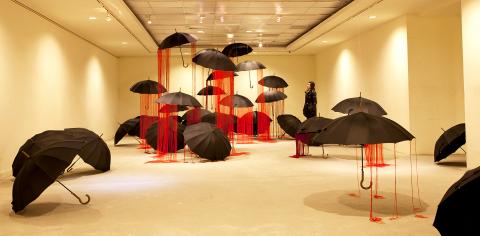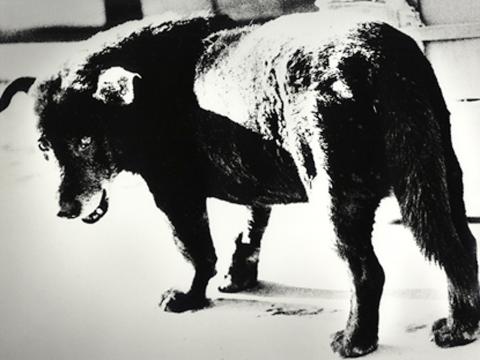The Red thread –Dream of 49 days is a solo exhibition by South Korean installation artist Hyewon Park. Park drapes red string over black umbrellas to serve as a metaphor for life and death. Specifically it examines the folk belief that the soul wanders the world for 49 days before moving on to its next incarnation. Each of the 49 umbrellas contain a book meant to serve as a kind of ghostly diary, divulging how the ties that “entangle” people in life — between humans and objects, animals and dreams — are gradually cut as the new life approaches. The idea of the red string plays off a number of cultural symbols — in the Asia, red string binds couples together — dating back to antiquity.
■ Barry Room, Taipei Artist Village (台北國際藝術村百里廳), 7 Beiping E Rd, Taipei City (台北市北平東路7號), tel: (02) 3393-7377. Open Tuesdays to Sundays from 11am to 9pm
■ Until April 14

Photo courtesy of TAV
Seeing Through Shadows brings together the work of three Japanese photographers: Araki Nobuyoshi, Moriyama Daido and Suda Issei. The exhibition serves to illustrate how photographic art repositioned itself and faced new challenges in Japan from the end of World War II to the 1970s. These artists made a definitive break with the pre-war photographic tradition, which mainly sought to mimic the aesthetic language of painting. In contrast, the three photographers on display use photography to express their response to dramatic social change. As a result, they and others gradually developed what American photography critic John Szarkowski called “Neo-Japanese photography,” which focused more on the individual style of “snapshots.”
■ Gallery 100 (百藝畫廊), 6, Ln 30, Changan E Rd Sec 1, Taipei City (台北市長安東路一段30巷6號), tel: (02) 2536-2120. Open Tuesdays to Sundays from 11am to 7pm
■ Until April 21

Photo courtesy of Gallery 100
Chinese artist Zhu Chunlin’s (朱春林) solo exhibition, Quietness and Peace (靜謐之在), reveals a realist painter of growing power and sophistication. His portraits and figurative works of women and children suggest in pastoral scenes and mannerist rooms suggest a life of leisure. But the sad expressions on their face reveal that something isn’t right in these scenes of apparent domestic bliss.
■ Elsa Art Gallery (雲清藝術中心), 3F, 1-1 Tianmu E Rd, Taipei City (台北市天母東路1-1號3樓), tel: (02) 2876-0386 Open Wednesdays to Sundays from 1pm to 7pm
■ Until April 21
Distilling the Soul’s Fragrance : Traditional Chinese Incense Culture (靈臺湛空明 -傳統香文化展) is an exhibit that provides a whirlwind tour of the uses of incense holders and the fragrant sticks themselves over the past thousand years. Whether as a status symbol of class or used in religious ceremonies as a means to achieving immortality, or as a sign of literary refinement, to its common use in folk culture, incense has always been an important part of Chinese culture.
■ National Museum of History (國立歷史博物館), 49 Nanhai Rd, Taipei City (台北市南海路49號), tel: (02) 2361-0270. Open Tuesdays to Sundays from 10am to 6pm. General admission: NT$30
■ Until May 5

April 28 to May 4 During the Japanese colonial era, a city’s “first” high school typically served Japanese students, while Taiwanese attended the “second” high school. Only in Taichung was this reversed. That’s because when Taichung First High School opened its doors on May 1, 1915 to serve Taiwanese students who were previously barred from secondary education, it was the only high school in town. Former principal Hideo Azukisawa threatened to quit when the government in 1922 attempted to transfer the “first” designation to a new local high school for Japanese students, leading to this unusual situation. Prior to the Taichung First

The Ministry of Education last month proposed a nationwide ban on mobile devices in schools, aiming to curb concerns over student phone addiction. Under the revised regulation, which will take effect in August, teachers and schools will be required to collect mobile devices — including phones, laptops and wearables devices — for safekeeping during school hours, unless they are being used for educational purposes. For Chang Fong-ching (張鳳琴), the ban will have a positive impact. “It’s a good move,” says the professor in the department of

On April 17, Chinese Nationalist Party (KMT) Chairman Eric Chu (朱立倫) launched a bold campaign to revive and revitalize the KMT base by calling for an impromptu rally at the Taipei prosecutor’s offices to protest recent arrests of KMT recall campaigners over allegations of forgery and fraud involving signatures of dead voters. The protest had no time to apply for permits and was illegal, but that played into the sense of opposition grievance at alleged weaponization of the judiciary by the Democratic Progressive Party (DPP) to “annihilate” the opposition parties. Blamed for faltering recall campaigns and faced with a KMT chair

Article 2 of the Additional Articles of the Constitution of the Republic of China (中華民國憲法增修條文) stipulates that upon a vote of no confidence in the premier, the president can dissolve the legislature within 10 days. If the legislature is dissolved, a new legislative election must be held within 60 days, and the legislators’ terms will then be reckoned from that election. Two weeks ago Taipei Mayor Chiang Wan-an (蔣萬安) of the Chinese Nationalist Party (KMT) proposed that the legislature hold a vote of no confidence in the premier and dare the president to dissolve the legislature. The legislature is currently controlled